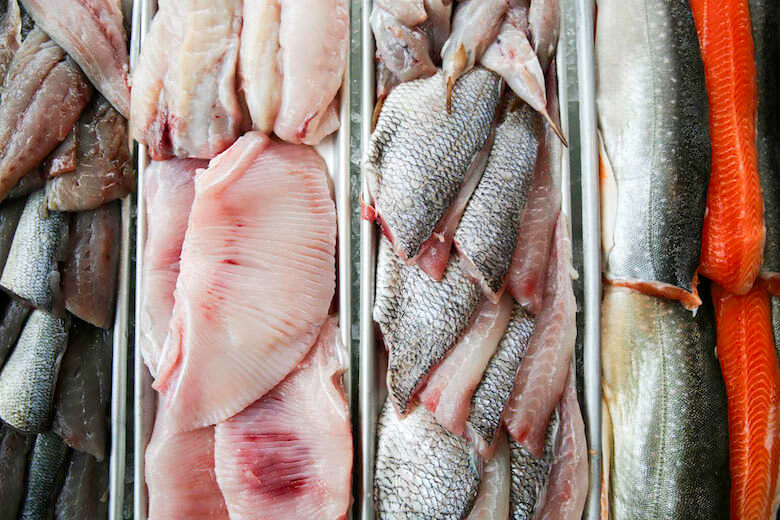
Walmart entering your home to stock your fridge with groceries, Amazon dropping Whole Foods hauls at your doorstep via drone, plant-based meat that “bleeds”—if this is increasingly how we’re eating in 2017, what can we expect in 2020? 2050? And given a growing world population and climate change concerns, which of these innovations do we actually need?
These are the big questions we’re exploring on November 3-4 at Food Loves Tech (FLT): our all you can eat and drink Industry City expo where you can test drive food technologies from field and sea to next gen frontiers. We’ll also have expert panels answering some of the most important questions facing our food supply including one entitled “How Can Tech Help Save Our Oceans?”
Dock to Dish is an international network of fishermen, scientists and seafood advocates that connects small-scale fisheries to regional communities through community- and restaurant-supported fishery programs. Sean Barrett founded the network in 2012 in Montauk, New York to build transparency in the seafood marketplace. Last month, Dock to Dish released a live tracking system for seafood, dubbed Dock to Dish 2.0. (Our writer Elizabeth Dunn—who covered the trouble and truth about buying sustainable seafood in our most recent innovation issue—detailed Dock to Dish 2.0 yesterday in the Wall Street Journal.)
Leading up to Food Loves Tech, we talked to Sean about traceability, climate change and the importance of knowing your fisherman.
Edible Brooklyn: Can you tell me about the decision of Dock to Dish to focus on seafood through the lens of transparency?
Sean Barrett: It’s important to first look at the state of seafood in the United States. 90% is imported and 50% is from aquaculture sources, mostly overseas in Asia. A lot of the wild seafood we import is unregulated, and of those imports only 1% is inspected by the FDA before it enters our food supply. Once the seafood is in the US, you’ve got staggering seafood labeling fraud rates. So when you look at the numbers you start to paint this picture like, yikes.
If you had to distill through all the confusion and scary statistics, it comes down to three words: know your fisherman. The platform we built from the very beginning has been about transparency and real traceability.

EB: So what is Dock to Dish doing to make seafood traceable?
SB: A month ago, we launched the first ever end-to-end real-time tracking with Dock to Dish 2.0. We partnered with Pelagic Data Systems, which is a really innovative company out in San Francisco focused on small-scale vessel tracking. We worked with their tech guys to get their tracking devices on both our boats and our delivery vehicles. Then we worked with the Fish Trax platform to weave this end-to-end tracking into their fisheries database system, which provides all of the information about the fisherman. This is all put together on a live digital dashboard on our website.
EB: How do you see technology playing a role in the sustainability of fisheries from an ecological perspective?
SB: Nowadays there is a lot of blue-washing, where people are saying their seafood is sustainable, but there are a lot of tricks. One example is this plague in the seafood industry of faux QR codes that the more nefarious seafood distributors can print in their office and put on seafood. It’s a trick that consumers are falling for. They punch in a code and it brings them to a static page with a fisherman’s picture. So we realized we needed to jump way out ahead technologically. Live tracking for wild seafood unequivocally is the future.
Sustainability is a kaleidoscope, and we have distilled it down to two principles: small footprint, big fingerprint. Fingerprint fish means that any seafood that comes through the Dock to Dish program is linked to an actual fisherman. That’s what you should be asking for—who caught this? Keep driving that question until it becomes commonplace.
The other piece is small footprint. Fishermen are on the front lines of climate change—we see it every day. There is this huge shift in fish migration patterns. So our number one focus these days is carbon footprint. The average distance traveled by seafood in the U.S. is well over 5000 miles, often by airplane, and the carbon produced is staggering. Dock to Dish fish never leaves a 150-mile radius of the port where it is landed.
EB: I’ve been hearing about fishermen selling their catch directly on Facebook and through other social media outlets. Have you seen that avenue of direct marketing in New York?
SB: In the Montauk area, if you go back 5 or 6 years ago, everyone was shocked and fascinated by what we were doing to reconnect the community with the fishery. We’ve seen tremendous progress with many local fishermen now selling directly to consumers and making themselves visible on social media.
We have brought a lot of media and video and pictures into the fisheries space, which was historically very camera shy. That was a big struggle for us early on. For a couple of years, I was squared off with people about what we were doing. Those guys these days are the biggest hugs I get at the dock. Because ultimately there are more dollars at the dock. We are eliminating that shady middle-man. It’s this fulfillment of this vision we’ve had for years. Seeing it coming true makes it easy to sleep at night.



